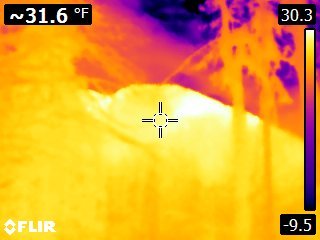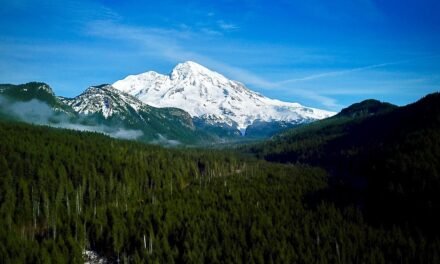I had a FLIR thermal camera over the weekend (looking for air leaks in the house) and could not resist taking it on a hike. It really gave an interesting perspective to what we normally see. For those of you who are wondering – a FLIR thermal camera shows you the infra-red rather than visible light – and the FLIR cameras are pretty sensitive in determining the temperature but the resolution of the images is pretty low compared to a normal digital camera. So what does a thermal view of a winter hike look like – I went out with Hunter for a couple of miles in the still snow-covered foothills of Mount Hood.
Rivers and Streams
Rivers and streams are currently warmer than their surroundings – this gives a truly surreal look like lava flowing through the landscape.

ZigZag River through trees 
Creek on Forest Road 19 
Creek on Forest Road 19
The temperature on the upper left is the approximate temperature in the center hotspot. The image on the left was taken at night where the outside temperature was about 20 degrees. However, you can see that the streams are running at a positively balmy 38 degrees.
Landscape and Forests
Even though it was just below freezing when we were out and about, the forest itself looks a little different when you look at it thermally. The trees and vegetation stay warmer than their surroundings (which is good for them).

Flag Mountain 
Flag Mountain 
Looking up between the trees

Plant leaves staying above freezing 
Lone Pine
As you’d expect a close-up of a plant leaf is above freezing – you can very clearly see the shape of the vegetation from the thermal picture.
Animals – well Hunter
Finally a look at Hunter – he is of course one of the hottest objects in the forest.

Sniffing around 
Rolling in the snow 
Looking back 
With coat on
You can clearly see that Hunter has a jacket on and that it helps some with providing insulation for him – of course, I’m not sure the value of the jacket if all he does is roll in the snow!
This was just a couple of miles up ZigZag mountain – the snow had started to get heavier but still plenty on the ground.


















